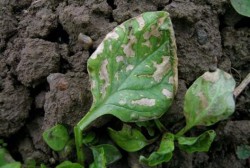Spinich Leafminer- Identification and Management
June 26, 2013

The adult fly appears in early to mid- May after overwintering in the soil as pupae. It is a about 5 mm long and are gray in color. The adults can be seen flying near the ground between the plants. The females deposit eggs singly or in rows of two to five side by side on the underside of the leaves. In as little as three days but more commonly in four to six days the tiny legless, white to yellowish maggots hatch from the eggs and work their way into the leaf tissue. The maggots feed between the upper and lower leaf surfaces of the host plants mining out the tissue in between. It is not unusual for several larvae to be in the same leaf. As the maggot grows and continues to feed, the mines, which are at first thread-like, become blotch-like and are easily seen on the infected leaves. The larvae are full-grown in 7 to 16 days when they drop to the ground and burrow a few inches into the soil to pupate. Two to four weeks later the adult flies emerge and will soon lay eggs for another generation. In New York you can expect three to four generations each year.
Management- a preventive spray schedule beginning when the spinach is two true leaves and repeated every 7 days. Remove wild hosts like lambsquarter, nightshades, chickweed, and plantain. Deep plowing in the spring can reduce the overwintering population by burying existing pupae. In smaller stands, infected leaves can be picked before the maggots drop to the ground. Removing and destroying these infected leaves can lessen the leafminer pressure
-Ray Range

Upcoming Events
2025 Potato Advisory Meeting
December 16, 2025
Canandaigua, NY
Come hear the latest on insect pest control and fertility management in potatoes from Cornell University experts. Potato variety trial updates will be shared too. After lunch will be the Empire State Potato Grower's Meeting. 1.5 DEC credits in 10, 1a, and 23.
2026 Finger Lakes Produce Auction Winter Growers Meeting
January 8, 2026
Penn Yan, NY
At this vegetable grower-focused meeting, ag industry experts will discuss food safety, disease management in strawberries, the benefits of using cover crops, plus more. Two grower panel discussions will focus on pest management techniques and irrigation. DEC recertification credits offered in categories 10, 1a, 21, 22, 23, and 24.


































